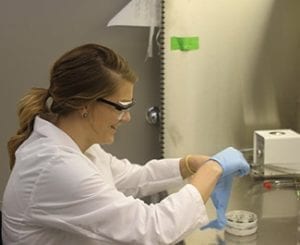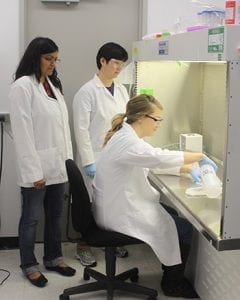News
From Haybales to Biotech and Back
 A biology major at Colorado Mesa University and summer intern in BTI’s Plant Genome Research Program, she grew up helping help father grow hay, alfalfa and oats on their farm in midwestern Colorado.
A biology major at Colorado Mesa University and summer intern in BTI’s Plant Genome Research Program, she grew up helping help father grow hay, alfalfa and oats on their farm in midwestern Colorado.
“I’ve helped my dad farm since I could walk, and that kind of got me interested in the agriculture aspect of biology,” said Middleton. “I just mainly want to do research to improve crops for future societies.”
Middleton is from Olathe, Colorado, a small farming community of just 1,900 people. Olathe is known for growing corn and even holds a sweet corn festival each year in August. Several generations back, relatives on her father’s side were homesteaders of a nearby town.
Her early interest in agriculture led her to look for summer internships in plant research and eventually into the laboratory of Joyce Van Eck, Assistant Professor and Director of the BTI Center for Plant Biotechnology Research. Middleton is working on a biotechnology project with Solanum prinophyllum, also known as the forest nightshade—a spiky, purple-berried plant native to the east coast of Australia.
 “She’s fantastic,” said Van Eck. “It’s clear that she’s got that spark.” Van Eck enjoys having interns in her laboratory because “it’s the sort of thing that you do everyday, but when you see it through the eyes of someone who is new to it, it really is exciting to be working in plant biotechnology.”
“She’s fantastic,” said Van Eck. “It’s clear that she’s got that spark.” Van Eck enjoys having interns in her laboratory because “it’s the sort of thing that you do everyday, but when you see it through the eyes of someone who is new to it, it really is exciting to be working in plant biotechnology.”
Surprisingly, Middleton is no stranger to Solanum plants either. During the school year, she does undergraduate research with a former professor, untangling the evolutionary relationships among a group of 12 plant species called Solanum section Androceras. These prickly, unusually flowered plants can be found from Texas to Ecuador, and have a mysterious family tree.
In her current work, Middleton is exploring a method that uses a soil bacterium called Agrobacterium tumefaciens, which is commonly used for plant biotechnology experiments. She is testing two different types of the bacteria on two life stages of forest nightshade to find the most efficient procedure. Once the protocol is optimized, the laboratory can use the plant as a fast-growing model species for genetic studies.

Postdoctoral scientist Sarika Gupta and research assistant Cynthia Du oversee Tawni Middleton at the hood.
“This is the first time they’ve worked with this plant. What I’m doing is the preliminary steps for everything,” said Middleton. “It’s really closely related to tomato, from what I understand, but it’s not an important crop plant.” The laboratory plans to use the plant to determine how widespread are the effects of certain genes shared by tomatoes and other related species.
Middleton first discovered BTI by searching the National Science Foundation website for summer internships. When she hit on Van Eck’s page, she knew she wanted to work in her laboratory at BTI.
“I actually contacted her in early August last year and asked about any internships,” she said. “I ended up getting the internship and getting in her lab so that was really exciting.”
After college, Middleton plans to attend graduate school to study plant biotechnology. Though she is open to the idea of a career in academia, she is most interested in pursuing research at a plant biotech company, such as Monsanto Co., to create improved crop varieties.
“Research is what I’m really passionate about it,” she said. “Any career that involves plant research is going to be fulfilling for me.”
BTI is now accepting applications for 2016 internships in Plant Genome Research and Bioinformatics.

